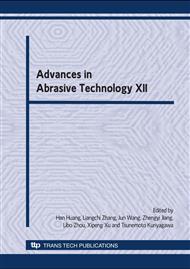p.678
p.684
p.690
p.696
p.702
p.708
p.713
p.719
p.725
Study on Mechanical Properties and Size Effect of Si3N4 Using Discrete Element Method
Abstract:
The mechanical models formed by packed circular discrete elements were used to investigate the mechanical properties of Si3N4. In these models, the distribution of elements is random in the specified region, and the average radius of elements is 6m. The main mechanical properties investigated here are Young’s modulus, compressive strength, Poisson’s ratio, fracture toughness and bending strength. Some numerical simulation analysis of the size effect of the mechanical properties in these discrete element models were carried out. The simulation results suggest that there is no obvious size effect for Young’s modulus, compressive strength and Poisson’s ratio in these discrete element models. However, for bending strength, when the number of elements in model is less than about 9000, there exists obvious size effect, with the increasing of the number of the elements, the size effect will become less and less until disappeared. The value of fracture toughness decreases with the increasing of the number of the model elements. The classical continuum fracture mechanics model about material fracture under tensile stress is also established by discrete element method. The simulation results are just the same as the simulation results of single edge notched bending (SENB) and the experimental values reported in other literatures. The results provide a more reliable foundation for the application of DEM in simulating the mechanical behaviors of advance ceramics.
Info:
Periodical:
Pages:
719-724
Citation:
Online since:
June 2009
Authors:
Price:
Сopyright:
© 2009 Trans Tech Publications Ltd. All Rights Reserved
Share:
Citation:


